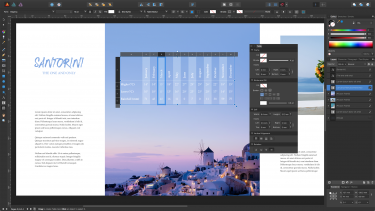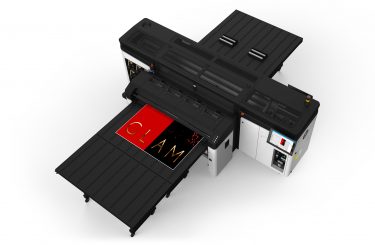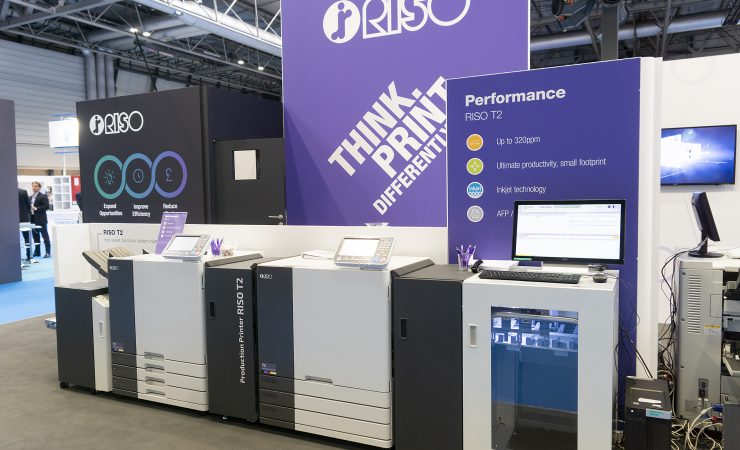Halfway between drupa shows it could have been expected that 2018 would be a fairly quiet year for product announcements, but there was plenty of action, says Simon Eccles.
Despite talk of the days of big print exhibitions being over (reinforced by news of the killing-off of the UK’s Ipex in July), the wish to make big announcements at a drupa still drives the innovations cycle. Most of the drupa 2016 announcements had reached the delivery stage by 2017, so 2018 was mainly going to be the year when suppliers concentrated on deliveries to bring the revenue in.
All the same there were enough significant new kit announcements to fill up Digital Printer’s 2018 news pages. Here is a roundup of what we think were the year’s most significant product announcements.
Inkjet action
While most of the last few drupa events have been dubbed ‘the inkjet drupa’, the products are rolling out steadily now. In February Ricoh announced new pigment inks and tweaked printheads for its 2015 Pro VC60000 high speed rollfed inkjet, intended to handle standard litho papers. In July it announced ProVC70000 with another new inkset and extended driers said to give litho-like quality at the top speed of 150m/min.
Riso revealed the production version of its £120,000 T2 inkjet press, shown as a prototype at drupa 2016. Claimed to be the world’s fastest cut-sheet inkjet press, it hits 320 A4 duplexed sheets per minute. It takes SRA3 sheets too, but A4 transactional print is the target market.
In September Xerox announced a speed bump for its established £465,000 Brenva HD SRA3 press, up from 197 to 275 A4 pages per minute, with 300 A4s achievable on some sheet sizes. Although slower than the Riso T2 it is built for much higher monthly volumes.
The year was rounded off in mid-November with Fujifilm’s announcement of the revised Jet Press 750S B2+ simplex sheet-fed inkjet press. It replaces the 720S from 2014 and is now claimed to be the fastest B2 inkjet press available (in a rather narrow field), thanks to new Samba printheads and improved dryers.

UK developed Affinity Publisher is hoping to challenge Adobe InDesign and Quark Xpress for page layout tool of choice next year
Toner presses
Although inkjet continued to progress, there is still life in toner, with plenty of activity in dry toner digital presses during 2018. Ricoh refreshed its range in several stages. March saw the announcement of the five-colour Pro C7200X for graphic arts applications and the four-colour Pro C7200 for lower cost needs. These replaced the mid-range C7100 from 2015, offering slightly higher performance and a range of tweaks including the ability for the C7200X to print white as an undercoat in the same pass as colour, which now includes fluorescent options.
In May Ricoh introduced Pro C9200, a major update of its range-topping C9100 with more automation and expanded media types and sizes – it can take sheet lengths up to 1030mm (duplex) or 1260mm (simplex) in weights up to 450gsm but doesn’t offer the additional colours of the C7200.
Kodak announced Nexfinity in March as the latest version of its high end NexPress family, claiming litho-competitive running costs. An optional feeder takes sheet lengths up to 1219mm and paper weights up to 530gsm. Also notable is the ability to change the laydown order for colours, so you could place a white undercoat on clear or coloured media, or print more than one special (including clear and metallics); previous NexPress models could only print specials last.
May saw the European launch of the Xerox Iridesse, an all-new high-end press with a lot of automation and new toners. Its standout feature is the ability to print six colours, with specials that include metallic gold and silver before and after the CMYK. White and clear toners are initially available, with the potential to print white under colour with a glossy spot varnish on top.
Xerox hit the news for other reasons throughout 2018 with its proposed on-off ‘merger’ takeover by Fujifilm, which led to a management coup by a couple of activist shareholders. Xerox’s future prospects are uncertain (a “directions” statement is due in February) and a miffed Fujifilm is suing Xerox for US$1 billion while still apparently considering a takeover under different terms.
Wide format
Turning to the wide format inkjet sector, the start of the year saw EFI begin selling its £99,000 Pro 24f flatbed in the UK. At EFI’s Connect event in January it announced two higher end hybrids, the HS125 F4 and HS100 F4 offering higher speeds than their predecessors, plus twin-zone printing/loading. At Fespa in May it announced a pair of 3.2m hybrid UV printers, the h3 and h5, offering 288 or 362sqm/hr respectively. An h3 can be field upgraded to the h5 (see also Product Focus on page 26).
InkTec’s Jetrix KX6U LED continued the company’s move into LED flatbeds with this £67,000, 2.5 x 1.3m model whose 30sqm/hr top speed is a lot faster than similarly priced rivals.
In February Durst announced a whole new hardware and software platform called P5, starting with the P5 250 HS, a 2.5m hybrid sheet-fed printer good for up to 240sqm/hr, resolutions up to 1200dpi and drop sizes down to 5pl. The 200HS, 320 and 200 models follow this. They use modified Fujifilm Dimatix heads and a range of new UV inks. Nearly a year on, Durst still hasn’t released basic specs other than the above for these machines, but it sold the first four printers to Dutch print and fulfilment house Probo in April.
Rumours of a latex ink flatbed printer from HP came true at Fespa in May, with the 2.5m width R2000, followed a few months later by the announcement of the smaller 1.6m R1000. These are the first serious attempts to print onto rigid media with anything other than UV-curable inks since Mutoh tried with a vegetable-based solvent ink about 10 years ago.
Epson replaced its SureColor SC-F2000 direct-togarment (DTG) pigment printer with the faster and generally improved SC-F2100 in January, while Ricoh entered the DTG market with the keenly priced Ri 100 around the same time.
In May Mutoh entered the full-sized UV flatbed market for the first time with the 1.6m ValueJet 1626UH. This is up against Roland, which also in May updated its UV-LED printer range with the VersaUV-S series of flatbed and belt-driven hybrid printers.
In September Mimaki expanded its dye sublimation textile range with the 1.8m TS55-1800, with a claim of high end functionality at entry/mid range pricing. A slightly oxymoronic Mini Jumbo Roll option allows lengthy unattended operations. Over the summer Mimaki’s full-colour 3D printer, the 3DUJ-P, arrived with UK distributor Hybrid Services. Results look great but with a price of about £170,000 it is likely to be a niche product.

HP brought out not one but two flatbed latex printers in 2018. This is the smaller of the two, the 1.6m R1000
Software
Prepress and workflow software progressed steadily with just a few standout releases. Perhaps the most significant developments were paving the way for the next-generation PDF 2.0: Global Graphics added support for PDF 2.0 with its Harlequin RIP-renderer and Adobe did the same with its equivalent APPE 5, which between them underpin most of the world’s prepress workflows. Agfa was the first to announce a commercially available workflow that supports PDF 2.0, with Apogee 11.
No commercial design or prepress programs export PDF 2.0 features yet, but expect that to change in 2019. PDF 2.0 introduces some useful new capabilities, particularly in colour handling, but industry wisdom says its real breakthrough will only come after July 2019 with the publication of the PDF/X-6 standard, which will be based on PDF 2.0.
HP was busy in front-end software, announcing a new Digital Wallpaper system in February, then the Piazza book-of-one software to work with its SiteFlow production software in April, followed in June by its One Package workflow to drive the C500 and PageWide T1190 corrugated presses.
For the past four years UK-based Serif Software has been offering its Affinity Designer and Affinity Photo programs as low-cost but well-specified alternatives to Adobe’s Illustrator and Photoshop within the dominant and now subscription-only Creative Cloud suite. Affinity programs are only £48.95 each (or £19.95 on iPad) as one-off costs for a perpetual licence. This autumn saw the release of a public Beta of Serif’s Affinity Publisher, a layout program that takes on Adobe’s InDesign and well as other established players such as QuarkXPress and Corel Draw. This is due for full release early in 2019.
Industry 4.0 and the future
Possibly an early marker for a new trend in service support, in June Bobst demonstrated the use of Epson’s Moverio smart glasses as part of its Connected Services Helpline Plus remote support. This is likely to cover its Mouvent inkjets in future. The smart glasses let Bobst’s service office talk to an on-site engineer and see video from the glasses, then display text, diagrams and light pointers projected into the glasses.
What else is on the tech horizon for 2019? Having given up trying to sell its Prosper inkjet operation in 2018, Kodak still intends to roll out development versions of its promising new UltraStream heads to third-party integrators in 2019. Landa is at last coming to a UK site with an S10P B1 perfecting Nanography press at Route One Print. There are no big international shows other than the wide formatcentred Fespa in May, but the Hunkeler Innovation Days due for February often trigger announcements of new roll-fed press configurations if not whole presses. Brexit remains a big unknown. Technology developments tend to be international, but the uncertainty of the UK’s economic prospects after March will surely affect sales prospects for months and years to come.





